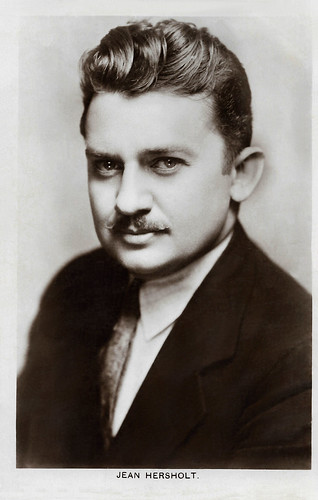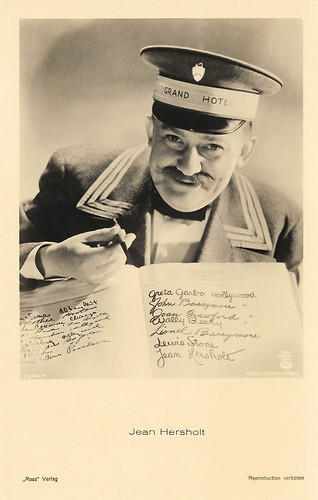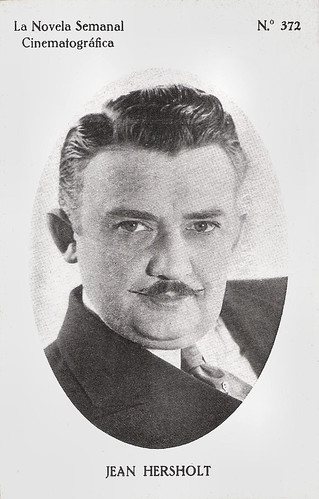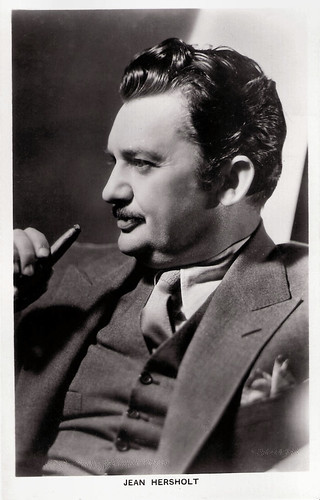Jean Hersholt (1886-1956) was a Danish-born actor who lived in the United States, where he appeared in 75 silent films and 65 sound films and directed four films. He was best known for his villain role in Erich von Stroheim's classic Greed (1924) and as Shirley Temple's grandfather in Heidi (1937). For 17 years he starred on American radio in Dr. Christian.

British postcard in the Picturegoer series, London, no. 360.

German postcard by Ross Verlag, no. 7244/1, 1932-1933, distributed in Italy by Casa Editrice Ballerini & Fratini, Firenze. Photo: Metro-Goldwyn-Mayer. Publicity still for Grand Hotel (Edmund Goulding, 1932).
Jean Pierre Carl Buron Hersholt (sources differ about his middle name) was born in Copenhagen, Denmark, in 1886. His father was a cigar salesman and his mother a singing girl. He graduated from the Copenhagen Art School. His first three short films were made for the Nordisk Film Kompagni in Denmark in 1906. These were Professorens Morgenavis/Professor's morning newspaper (Louis Halberstadt, Viggo Larsen, 1906) with Max Freitag, Konfirmanden/Confirmand (Louis Halberstadt, 1906) and En ny hat til Madammen/A New Hat for Madam (Viggo Larsen, 1906).
He emigrated to the US in 1913, and the remainder of his films were made in America. He was an extra in early silent films Westerns like The Disciple (William S. Hart, 1915), Hell's Hinges (Charles Swickard, William S. Hart and Clifford Smith, 1916) and The Aryan (William S. Hart, 1916), both starring William S. Hart and produced by Thomas H. Ince. He played a priest in the silent Western The Soul Herder (John Ford, 1917) featuring Harry Carey. By the 1920s his roles were substantial feature pieces, but most of these were as villains. Hal Erickson at AllMovie: "Hersholt was firmly entrenched as the slimiest and most monstrous of movie villains."
He had one of his first leading roles as the servant in the silent drama The Servant in the House (Jack Conway, 1921) based on a 1908 Broadway play, 'The Servant in the House' by Charles Rann Kennedy. The film was already shot in 1918 by the historic Triangle Film Corporation, but by 1920, Triangle had gone out of business. The film had a limited release in mid-1920 and was acquired by a different distributor in late 1920 for re-release in 1921. Then followed supporting parts in films like the drama Jazzmania (Robert Z. Leonard, 1923) starring Mae Murray. Hersholt's best-remembered silent film is Greed (Erich von Stroheim, 1924) based on the 1899 Frank Norris novel McTeague. It stars Gibson Gowland as Dr. John McTeague, ZaSu Pitts as Trina Sieppe, his wife, and Hersholt as McTeague's friend and eventual enemy Marcus Schouler. Greed was one of the few films of its time to be shot entirely on location, with Von Stroheim shooting approximately 85 hours of footage before editing. Two months alone were spent shooting in Death Valley for the film's final sequence, and many of the cast and crew became ill.
According to William McPeak at IMDb, Hersholt endured the heat like a veteran but required a hospital stay after sweating away 27 pounds. Von Stroheim used sophisticated filming techniques such as deep-focus cinematography and montage editing. He considered Greed to be a Greek tragedy, in which environment and heredity controlled the characters' fates and reduced them to primitive bête humaines (human beasts). Greed was a critical and financial failure upon its initial release, but by the 1950s it began to be regarded as one of the greatest films ever made. In the silent drama Stella Dallas (Henry King, 1925), Hersholt co-starred with Ronald Colman, Belle Bennett and Douglas Fairbanks Jr. Other silent films were My Old Dutch (Laurence Trimble, 1926), the crime drama The Old Soak (Edward Sloman, 1926) and Alias the Deacon (Edward Sloman, 1927).
Ernst Lubitsch directed him in The Student Prince in Old Heidelberg (1927) as the tutor of Ramón Novarro. Though now considered a classic by many film historians, it was far from a unanimous critical success during its original theatrical run. In the silent romantic-comedy 13 Washington Square (Melville W. Brown, 1928) he starred with Alice Joyce and ZaSu Pitts, and in The Secret Hour (Rowland V. Lee, 1928) with Pola Negri. He was directed by legendary D.W. Griffith in the comedy The Battle of the Sexes (1928) a remake by Griffith of an earlier film he directed in 1914, which starred Lillian Gish. The film was released as both a silent film and a sound version using the Movietone sound-on-film system. He then starred in the part-talkie drama The Younger Generation (1929) directed by Frank Capra.

German postcard by Ross Verlag, no. 98/2. Photo: Metro-Goldwyn-Mayer. Publicity still for The Student Prince of Old Heidelberg (Ernst Lubitsch, 1927) with Ramón Novarro.

German postcard by Ross Verlag, no. 111/1. Photo: Paramount. Charles Rogers, Nancy Carroll, and Jean Hersholt in Abie's Irish Rose (Victor Fleming, 1928). It was based on a popular Broadway play.
Jean Hersholt’s first all-mono sound film was The Climax (Renaud Hoffman, 1930) with Kathryn Crawford as a young Italian girl who wants to become a great opera singer. Despite his Danish accent, Hersholt had a pleasant, mellow voice and a camera-friendly presence that ensured him continued success. He co-starred in the action-adventure The Third Alarm (Emory Johnson, 1930) with Anita Louise and produced and released by Tiffany Pictures, a faltering B movie silent studio that tried to become a major.
For United Artists he co-starred with Lupe Velez in Hell Harbor (Henry King, 1930) and for MGM with Greta Garbo and Clark Gable in Susan Lenox (Her Fall and Rise) (Robert Z. Leonard, 1931). He supported Boris Karloff and Myrna Loy in The Mask of Fu Manchu (Charles Brabin, 1932), and Marie Dressler and Jean Harlow in Dinner at Eight (George Cukor, 1933).
He played Senf, the porter, in Grand Hotel (Edmund Goulding, 1932), also with Greta Garbo, and reunited with Clark Gable in Men in White (Ryszard Bolesławski, 1934). In The Country Doctor (Henry King, 1936), starring the Canadian Dionne quintuplets, Hersholt portrayed Dr. John Luke, a character based on Dr. Allan Roy Dafoe, the obstetrician who delivered and cared for the Dionne quintuplets. Two sequels followed.
Hersholt wanted to do the role on radio, but could not get the rights. He decided to create his own doctor character for radio, and since he was a Hans Christian Andersen enthusiast, he borrowed that name for his character of the philosophical Dr. Paul Christian who practised in the Midwest town of River's End with the assistance of Nurse Judy Price.
Dr. Christian was introduced on CBS in 1937. The radio series became a popular long-running hit, continuing on CBS until 6 January 1954, with Hersholt so strongly identified with the role that he received mail asking for medical advice. Various spin-offs were produced, as Hersholt co-wrote a Dr. Christian novel and made a series of six family films as Christian from 1939 to 1941, for instance, Dr. Christian Meets the Women in 1940. In 1956, his Dr. Christian character made the transition to television, scripted by Gene Roddenberry, with Macdonald Carey as his nephew.

Spanish card by La Novela Semanal Cinematográfica, no. 372.

British postcard in the Picturegoer series, London, no. 360a.
Jean Hersholt’s best-remembered film role is possibly Shirley Temple's beloved grandfather in Heidi (Allan Dwan, 1937), a film version of the 1880 children's book written by Swiss author Johanna Spyri. The film was a success and Temple enjoyed her third year in a row as number one box office draw. Later films include the mystery Mr. Moto in Danger Island (I. Leeds, 1939), starring Peter Lorre.
In 1939, Jean Hersholt helped form the Motion Picture Relief Fund to support industry employees with medical care when they were down on their luck. The fund was used to create the Motion Picture Country House and Hospital in Woodland Hills, California, and it led to the creation in 1956 of the Jean Hersholt Humanitarian Award, an honorary Academy Award given to an "individual in the motion picture industry whose humanitarian efforts have brought credit to the industry”.
From 1945 to 1949, Hersholt was the President of the Academy of Motion Picture Arts and Sciences. During his long career in the cinema, his roles ranged from early silent villains to secondary parts in which his mild Danish accent and pleasant voice suited him to depict a succession of benevolent fathers, doctors, professors, and European noblemen. Hersholt's last role was in Run for Cover (Nicholas Ray, 1955) with James Cagney and Viveca Lindfors.
Jean Hersholt translated over 160 of Andersen's fairy tales into the English language. These were published in 1949 in six volumes as The Complete Andersen. His large collection of Hans Christian Andersen books is now in the Library of Congress. Hersholt was lauded with three Academy Awards for his own charity work, and in 1948, he was knighted by King Christian X of Denmark.
In 1914, Hersholt married his wife Vita. They had two sons, Jean Hersholt Jr. and Allan Hersholt. He was the paternal half-uncle of the late actor Leslie Nielsen and former Canadian Deputy Prime Minister Erik Nielsen. In 1956, Jean Hersholt died of cancer in Hollywood at the age of 69. He is interred in Forest Lawn Memorial Park Cemetery in Glendale, California. His grave is marked with a statue of Klods-Hans (Clumsy Hans), a Hans Christian Andersen character who left home to find his way in the world — much as Hersholt himself had done.
The last fight scene in Greed (1924). Source: Cinema History (YouTube).
Trailer Grand Hotel (1932). Source: Old School Trailers (YouTube).
Sources: William McPeak (IMDb), Hal Erickson (AllMovie), Wikipedia and IMDb.
This post was last ypdated on 9 September 2024.

British postcard in the Picturegoer series, London, no. 360.

German postcard by Ross Verlag, no. 7244/1, 1932-1933, distributed in Italy by Casa Editrice Ballerini & Fratini, Firenze. Photo: Metro-Goldwyn-Mayer. Publicity still for Grand Hotel (Edmund Goulding, 1932).
The slimiest and most monstrous of movie villains
Jean Pierre Carl Buron Hersholt (sources differ about his middle name) was born in Copenhagen, Denmark, in 1886. His father was a cigar salesman and his mother a singing girl. He graduated from the Copenhagen Art School. His first three short films were made for the Nordisk Film Kompagni in Denmark in 1906. These were Professorens Morgenavis/Professor's morning newspaper (Louis Halberstadt, Viggo Larsen, 1906) with Max Freitag, Konfirmanden/Confirmand (Louis Halberstadt, 1906) and En ny hat til Madammen/A New Hat for Madam (Viggo Larsen, 1906).
He emigrated to the US in 1913, and the remainder of his films were made in America. He was an extra in early silent films Westerns like The Disciple (William S. Hart, 1915), Hell's Hinges (Charles Swickard, William S. Hart and Clifford Smith, 1916) and The Aryan (William S. Hart, 1916), both starring William S. Hart and produced by Thomas H. Ince. He played a priest in the silent Western The Soul Herder (John Ford, 1917) featuring Harry Carey. By the 1920s his roles were substantial feature pieces, but most of these were as villains. Hal Erickson at AllMovie: "Hersholt was firmly entrenched as the slimiest and most monstrous of movie villains."
He had one of his first leading roles as the servant in the silent drama The Servant in the House (Jack Conway, 1921) based on a 1908 Broadway play, 'The Servant in the House' by Charles Rann Kennedy. The film was already shot in 1918 by the historic Triangle Film Corporation, but by 1920, Triangle had gone out of business. The film had a limited release in mid-1920 and was acquired by a different distributor in late 1920 for re-release in 1921. Then followed supporting parts in films like the drama Jazzmania (Robert Z. Leonard, 1923) starring Mae Murray. Hersholt's best-remembered silent film is Greed (Erich von Stroheim, 1924) based on the 1899 Frank Norris novel McTeague. It stars Gibson Gowland as Dr. John McTeague, ZaSu Pitts as Trina Sieppe, his wife, and Hersholt as McTeague's friend and eventual enemy Marcus Schouler. Greed was one of the few films of its time to be shot entirely on location, with Von Stroheim shooting approximately 85 hours of footage before editing. Two months alone were spent shooting in Death Valley for the film's final sequence, and many of the cast and crew became ill.
According to William McPeak at IMDb, Hersholt endured the heat like a veteran but required a hospital stay after sweating away 27 pounds. Von Stroheim used sophisticated filming techniques such as deep-focus cinematography and montage editing. He considered Greed to be a Greek tragedy, in which environment and heredity controlled the characters' fates and reduced them to primitive bête humaines (human beasts). Greed was a critical and financial failure upon its initial release, but by the 1950s it began to be regarded as one of the greatest films ever made. In the silent drama Stella Dallas (Henry King, 1925), Hersholt co-starred with Ronald Colman, Belle Bennett and Douglas Fairbanks Jr. Other silent films were My Old Dutch (Laurence Trimble, 1926), the crime drama The Old Soak (Edward Sloman, 1926) and Alias the Deacon (Edward Sloman, 1927).
Ernst Lubitsch directed him in The Student Prince in Old Heidelberg (1927) as the tutor of Ramón Novarro. Though now considered a classic by many film historians, it was far from a unanimous critical success during its original theatrical run. In the silent romantic-comedy 13 Washington Square (Melville W. Brown, 1928) he starred with Alice Joyce and ZaSu Pitts, and in The Secret Hour (Rowland V. Lee, 1928) with Pola Negri. He was directed by legendary D.W. Griffith in the comedy The Battle of the Sexes (1928) a remake by Griffith of an earlier film he directed in 1914, which starred Lillian Gish. The film was released as both a silent film and a sound version using the Movietone sound-on-film system. He then starred in the part-talkie drama The Younger Generation (1929) directed by Frank Capra.

German postcard by Ross Verlag, no. 98/2. Photo: Metro-Goldwyn-Mayer. Publicity still for The Student Prince of Old Heidelberg (Ernst Lubitsch, 1927) with Ramón Novarro.

German postcard by Ross Verlag, no. 111/1. Photo: Paramount. Charles Rogers, Nancy Carroll, and Jean Hersholt in Abie's Irish Rose (Victor Fleming, 1928). It was based on a popular Broadway play.
A camera-friendly presence
Jean Hersholt’s first all-mono sound film was The Climax (Renaud Hoffman, 1930) with Kathryn Crawford as a young Italian girl who wants to become a great opera singer. Despite his Danish accent, Hersholt had a pleasant, mellow voice and a camera-friendly presence that ensured him continued success. He co-starred in the action-adventure The Third Alarm (Emory Johnson, 1930) with Anita Louise and produced and released by Tiffany Pictures, a faltering B movie silent studio that tried to become a major.
For United Artists he co-starred with Lupe Velez in Hell Harbor (Henry King, 1930) and for MGM with Greta Garbo and Clark Gable in Susan Lenox (Her Fall and Rise) (Robert Z. Leonard, 1931). He supported Boris Karloff and Myrna Loy in The Mask of Fu Manchu (Charles Brabin, 1932), and Marie Dressler and Jean Harlow in Dinner at Eight (George Cukor, 1933).
He played Senf, the porter, in Grand Hotel (Edmund Goulding, 1932), also with Greta Garbo, and reunited with Clark Gable in Men in White (Ryszard Bolesławski, 1934). In The Country Doctor (Henry King, 1936), starring the Canadian Dionne quintuplets, Hersholt portrayed Dr. John Luke, a character based on Dr. Allan Roy Dafoe, the obstetrician who delivered and cared for the Dionne quintuplets. Two sequels followed.
Hersholt wanted to do the role on radio, but could not get the rights. He decided to create his own doctor character for radio, and since he was a Hans Christian Andersen enthusiast, he borrowed that name for his character of the philosophical Dr. Paul Christian who practised in the Midwest town of River's End with the assistance of Nurse Judy Price.
Dr. Christian was introduced on CBS in 1937. The radio series became a popular long-running hit, continuing on CBS until 6 January 1954, with Hersholt so strongly identified with the role that he received mail asking for medical advice. Various spin-offs were produced, as Hersholt co-wrote a Dr. Christian novel and made a series of six family films as Christian from 1939 to 1941, for instance, Dr. Christian Meets the Women in 1940. In 1956, his Dr. Christian character made the transition to television, scripted by Gene Roddenberry, with Macdonald Carey as his nephew.

Spanish card by La Novela Semanal Cinematográfica, no. 372.

British postcard in the Picturegoer series, London, no. 360a.
Shirley Temple's beloved grandfather
Jean Hersholt’s best-remembered film role is possibly Shirley Temple's beloved grandfather in Heidi (Allan Dwan, 1937), a film version of the 1880 children's book written by Swiss author Johanna Spyri. The film was a success and Temple enjoyed her third year in a row as number one box office draw. Later films include the mystery Mr. Moto in Danger Island (I. Leeds, 1939), starring Peter Lorre.
In 1939, Jean Hersholt helped form the Motion Picture Relief Fund to support industry employees with medical care when they were down on their luck. The fund was used to create the Motion Picture Country House and Hospital in Woodland Hills, California, and it led to the creation in 1956 of the Jean Hersholt Humanitarian Award, an honorary Academy Award given to an "individual in the motion picture industry whose humanitarian efforts have brought credit to the industry”.
From 1945 to 1949, Hersholt was the President of the Academy of Motion Picture Arts and Sciences. During his long career in the cinema, his roles ranged from early silent villains to secondary parts in which his mild Danish accent and pleasant voice suited him to depict a succession of benevolent fathers, doctors, professors, and European noblemen. Hersholt's last role was in Run for Cover (Nicholas Ray, 1955) with James Cagney and Viveca Lindfors.
Jean Hersholt translated over 160 of Andersen's fairy tales into the English language. These were published in 1949 in six volumes as The Complete Andersen. His large collection of Hans Christian Andersen books is now in the Library of Congress. Hersholt was lauded with three Academy Awards for his own charity work, and in 1948, he was knighted by King Christian X of Denmark.
In 1914, Hersholt married his wife Vita. They had two sons, Jean Hersholt Jr. and Allan Hersholt. He was the paternal half-uncle of the late actor Leslie Nielsen and former Canadian Deputy Prime Minister Erik Nielsen. In 1956, Jean Hersholt died of cancer in Hollywood at the age of 69. He is interred in Forest Lawn Memorial Park Cemetery in Glendale, California. His grave is marked with a statue of Klods-Hans (Clumsy Hans), a Hans Christian Andersen character who left home to find his way in the world — much as Hersholt himself had done.
The last fight scene in Greed (1924). Source: Cinema History (YouTube).
Trailer Grand Hotel (1932). Source: Old School Trailers (YouTube).
Sources: William McPeak (IMDb), Hal Erickson (AllMovie), Wikipedia and IMDb.
This post was last ypdated on 9 September 2024.
No comments:
Post a Comment